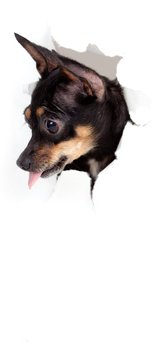Portrait Photography: Tips and Methods
Portrait is defined as, "A likeness of a person, especially one showing the face, that is created by a painter or photographer, for example." In the area of portrait photography there are some guidelines that you should consider when you go to take photos of people.
The different types of portraits are: close-ups, facial shots, upper body shots or environmental portraits. Environmental portraits are where you focus on the subject and on their surroundings that provide more character to the subject.
When people have a camera in their face it usually makes them nervous and they will try to put on a face that does not portray who they really are. The real skill to portrait photography is trying to capture photos when the subjects are comfortable and not worried about a camera.
Many professional photographers try to capture their subject's true essence by using tricks. One example of this is counting to three so the subject prepares and then while they are relaxing after taking a planned photo the photographer will snap a few more unplanned photos. In most cases the subject won't even know that more than one photo was taken but it's usually the photos that the subject wasn't expecting that capture their true essence.
Another more common strategy professionals use is to tell funny jokes that make their subjects genuinely laugh or smile. I'm sure that you have probably experienced something like this yourself.
CLOSE-UP PORTRAITS
These usually have the subject's shoulders and head or less. They are framed around the face. These are the most common and best at capturing expressions and glamour shots. For these it is very important to have the light coming from a good angle. To accent wrinkles or small details you should have the light coming from the side or from the top. To create flattering pictures you should choose a cloudy day or try to create diffused light so there are hardly any shadows. Also make sure the subject is brighter than the background to reduce distraction.
For close-up portraits you should use a wide aperture (low f/stop) to make the background out of focus and therefore less of a distraction. Professionals commonly use a fixed telephoto lens that's 90 mm or higher for portraits in order to de-emphasize the subject's nose or any other unflattering feature. It works because at that distance the nose or any other feature does not seem closer to the camera than the rest of the face.
UPPER BODY OR MIDRANGE PORTRAITS
These are easier to capture because the subject is probably more relaxed because it's less personal. These include a little more of the background than close-ups. These are commonly used for both single subjects and multiple subjects. This is the kind of portrait used to mark occasions such as graduation, yearbook, birthdays and other parties. The ideal lens would be about a 90 mm fixed telephoto or more wide angle depending on how many subjects there are.
ENVIRONMENTAL PORTRAITS
These are the portraits that let you into the life of a subject. They might include the whole subject in a scenario or the subject participating in some hobby that they enjoy. These are best for telling a story to the viewer about the subject. They are almost always used by photojournalists to look into the lives of interesting people. They also make great Black and White pictures.
Use this information to develop what kind of portrait style you would like to take, and then practice it before dealing with any serious clients.
Richard Schneider is a digital photography enthusiast and founder of http://www.picturecorrect.com/ which offers tips and news about digital photography, digital camera reviews, photoshop tutorials and computer wallpaper.
|
|
|
|
|
|
|
|
|
|
|


How a Digital Camera Works
The digital camera is not something of a magic box... Read More
Understanding Digital Photography
Most serious photographers and all professionals use a Single Lens... Read More
Digital Camera Basics
Digital Camera Basics? The VocabularyShopping for a digital camera can... Read More
The Advantages of Underwater Camera Housing
You will need an underwater camera housing to keep your... Read More
How to Buy a Digital Camera
Are you buying your first digital camera? Well, you must... Read More
Portrait Photography: Tips and Methods
Portrait is defined as, "A likeness of a person, especially... Read More
10 MORE Ways to Make Money with Your Digital Cameras
1. Pet photos - advertise a Pet Photography business where... Read More
What Should You Look for in a New Camera?
These parameters are discussed at 2 levels: -Based on... Read More
Crooked Horizons in Your Photos? ? Here is a Five Minute Digital Fix
Remember the good old photography days?Film camera in hand, you... Read More
The Photography Portfolio: Building Your Reputation
If you have hopes of becoming a professional photographer, or... Read More
Kodak Digital Cameras - The Giant Comes To Digital
George Eastman, founder of Kodak is world renowned today. Digital... Read More
How to Take Great Photos of Your Child
Children are naturally photogenic. Ive worked in studios and children... Read More
Video Camcorder Formats and Media
There are way too many tape, disk and stick formats... Read More
How to Take Better Photos of Your Baby or Toddler
Every Mom wants to take great photos of their babies... Read More
Everybody is Fixing Their House or Apartment Up These Days. Use That Digital Camera to Capture
That's right, you go through all the trouble of making... Read More
How to Easily Select the Important Photography Category for Your Home Based Business
You may have already started to make money from your... Read More
Infrared Photography and Big City Crime
One of the major problems of the larger cities of... Read More
Digital RAW Workflow for Beginners
Having an efficient work flow is essential for photographers. In... Read More
Digital Camera Reviews and Ratings De-Mystify the Choices
Shopping for a new digital camera can be quite frustrating... Read More
Selecting Good Stock Photography in the Age of Digital
The business of stock photography has drastically changed over the... Read More
Wildlife Scouting Cameras
For years I wondered how big the bucks were that... Read More
Applications of Underwater Video Cameras
There's so much you can do with an underwater video... Read More
Types of Digital Cameras
If you are in the market to purchase a digital... Read More
Panasonic Digital Cameras - The History Behind Their Cameras
Panasonic is a world-renowned consumer electronics company today. Its digital... Read More
Choosing The Right Digital Camera
Let's get something straight right out of the box. If... Read More
Digital Camera Memory Cards
A digital camera accessory you should purchase is a spare... Read More
Light Meter Readings for Film and Digital
Reflected Light Readings for Film and Digital ImagesIn order to... Read More
How To Reduce Red Eye The Easy Way With Any Pro Or Point & Shot Camera
There is one simple technique any body can do to... Read More
The Truth About Pixels, Part 2-1: Printing 4x3 Inch Photos
Why is a 3 megapixel camera better than a 1... Read More
Fuji Digital Cameras
Fuji digital cameras entered the market in the late 90's.... Read More
Using a Camcorder to Record Family Events Quickly and Easily
Let's start there (but not spend too much time on... Read More
Why 1.5 Megapixels is Enough
Dots Per Inch is a useful measure of relative resolution.... Read More
Where Do Great Ideas Come From?
At a Photo Club meeting I attended recently, the President... Read More


How to Take Great Photos of Your Child
Children are naturally photogenic. Ive worked in studios and children... Read More
Taking Professional Quality Pictures
By now I'm sure you've used Either a digital or... Read More
Digital SLR Camera versus a Compact Digital Camera
Digital Single Lens Reflex (SLR) cameras are excellent cameras that... Read More
The Truth About Pixels, Part 2-1: Printing 4x3 Inch Photos
Why is a 3 megapixel camera better than a 1... Read More
Using a Camcorder to Record Family Events Quickly and Easily
Let's start there (but not spend too much time on... Read More
Getting the Most From Your Digital Camera Memory Card
Imagine taking your new digital camera on a vacation and... Read More
Removing Cracks and Creases when Restoring Old Photos ? 5 Minute Digital Fix
A common problem with old photos is that they often... Read More
How to Shoot Video of Your Kids Sports Team So That Anyone Else Will Watch It!
Break out that video camera, there is a game this... Read More
Terms Used The In The Stock Photography Business
So you are a small business person or web designer... Read More
Review of the Photek Product Shooting Tent
Here's the challenge. You have to photograph small items for... Read More
Nikon Digital Cameras - Cool(pix) and Functional
Even though Nikon entered the camera world by 1948, today... Read More
How to Create a Family History Video Memoir with Photos and Interviews of Your Loved Ones
Here are examples of two basic videos you can create... Read More
Take Spectacular Nighttime Photos with Your Digital Camera - Part II
Night photos can take on a somewhat magical quality you... Read More
The Truth About Pixels - Part I: Digital Cameras
Most digital cameras today boast of greater resolution and picture... Read More
Memories That Get Lost
How many people have pictures in a shoe box? In... Read More
The Best Wildlife Camera To Take On Safari
Good wildlife camera equipment on safari can make the difference... Read More
Digital Cameras Demystified
Demystifying Digital Camera JargonWant to buy a digital camera but... Read More
Use A Tripod!
Using a tripod is essential when taking photos - and... Read More
The Arizona Desert Museum
The vast beauty and richness of the desert can be... Read More
Applications of Underwater Video Cameras
There's so much you can do with an underwater video... Read More
Digicam File Formats
Looking at the digital camera, a person can visualize it... Read More
Making Money With Digital Photography And Live Events
A few years ago I became interested in digital photography,... Read More
Cropping Digital Photos Into Shape
Did you know that in many cases digital photos are... Read More
How to Photograph Your Baby
Babies make the best and the worst subjects to photograph.... Read More
Start Your Own Photography Business from Home
Anyone with the right camera equipment, and the necessary skills... Read More
Picture Framing for Photographers - Part 1
Imagine being able to frame all your own photographs just... Read More
How To Reduce Red Eye The Easy Way With Any Pro Or Point & Shot Camera
There is one simple technique any body can do to... Read More
Getting Your Photos Ready for Sharing
One of the main reasons people buy digital cameras is... Read More
A Guide to Disposable Digital Cameras
Disposable Cameras (also called single-use cameras) first came on the... Read More
Proper Handling and Storage of Paper Photos
Youv'e taken that perfect photo in the perfect light at... Read More
Travel and Scenic Photography 101
When you're driving through the mountains somewhere, and you... Read More
7 Things You Must Do If You Want To Make That Perfect Camera Shot
Saturate yourself with your subject and the camera will all... Read More
Digital Camera Batteries
Every device needs a driving force to operate, just as... Read More
Photography |